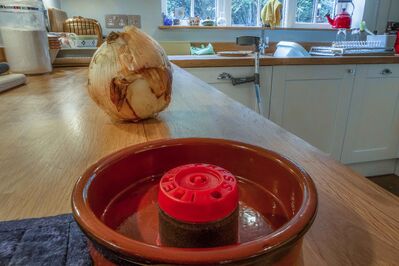Pigeonhill (talk | contribs) No edit summary Tag: Visual edit |
Pigeonhill (talk | contribs) No edit summary Tag: Visual edit |
||
| (41 intermediate revisions by the same user not shown) | |||
| Line 1: | Line 1: | ||
| − | == |
+ | ==Get Focus Brackets== |
| − | :''' |
+ | :'''Tested on:''' S95, G5X, G7X, G1X and M3 |
| − | : |
+ | :Should also work on other CHDK cameras |
| − | :''' |
+ | :'''Requires CHDK build:''' 1.5 or higher |
| − | + | The non M3 version of this script may be downloaded from: https://gist.github.com/pigeonhill/3fe9e52621db7149eb3505bd60b395cb |
|
| + | The M3 version uses a split thin lens model (which is different to the non-M3 versions). In the M3 version you can add your own lens data to the script or carry out a simple measurement to estimate the lens thickness, see http://photography.grayheron.net/2020/07/a-credit-card-based-generalised-focus.html |
||
| − | '''Notes & Usage''' Unlike macro focus bracketing, where the focus step is the same each time and very small; in landscape focus bracketing we need to calculate the focus for each step. To get the full |
||
| + | |||
| − | benefits from this script, it is useful to remember that, ignoring diffraction, at the near and far depth of fields the defocus blur is, by definition, the so-called Circle of Confusion. This blur is usually accepted as being 30 microns for a 35mm full frame camera, and scaled by the crop factor for other formats, eg 11 microns on the G7X. |
||
| + | The M3 version may be downloaded from here: https://gist.github.com/pigeonhill/cdf25239bae6a4343e6431fb4c10c849 |
||
| + | |||
| + | '''Notes & Usage''' Unlike macro focus bracketing, where the focus step is the same each time and very small; in landscape focus bracketing we need to calculate the focus for each step. To get the full benefits from this script, it is useful to remember that, ignoring diffraction, at the near and far depth of fields the defocus blur is, by definition, the so-called Circle of Confusion. This blur is usually accepted as being 30 microns for a 35mm full frame camera, and scaled by the crop factor for other formats, eg 11 microns on the G7X. |
||
Having said this, 30 microns, is not the 'best focus' quality but you will not see the differences on your Facebook images, only when you create high (focus) quality prints that will be scrutinised close up, eg in a competition. As you need a line pair (black and white pixels, to see a line, it is not sensible to consider CoCs less than, say, 2 sensor pixels. |
Having said this, 30 microns, is not the 'best focus' quality but you will not see the differences on your Facebook images, only when you create high (focus) quality prints that will be scrutinised close up, eg in a competition. As you need a line pair (black and white pixels, to see a line, it is not sensible to consider CoCs less than, say, 2 sensor pixels. |
||
| Line 23: | Line 26: | ||
and have an overlap between the focus brackets. The script provides four options for this overlap: none, 2*CoC/3, CoC/2 and diffraction aware. |
and have an overlap between the focus brackets. The script provides four options for this overlap: none, 2*CoC/3, CoC/2 and diffraction aware. |
||
| − | With diffraction aware overlap, the script calculates the defocus blur to use |
+ | With diffraction aware overlap, the script calculates the defocus blur to use that ensures that the defocus blur and diffraction blur, taken together in quadrature, are equal to the CHDK CoC. This overlap blur criterion will never be less than the CHDK set CoC/3. |
The following illustrates the overlap between image n and n+1. Note that using the overlap feature comes at the cost of needing to take more brackets |
The following illustrates the overlap between image n and n+1. Note that using the overlap feature comes at the cost of needing to take more brackets |
||
| Line 30: | Line 33: | ||
Having achieved the perfect focus brackets, the script will then create an additional bracket beyond H, ie to cover the infinity focus quality. The options being 2H, 3H or 4H, giving infinity blurs of CoC/2, CoC/3 or CoC/4. If diffraction aware is being used for the overlap, the last image will be around CoC/3. |
Having achieved the perfect focus brackets, the script will then create an additional bracket beyond H, ie to cover the infinity focus quality. The options being 2H, 3H or 4H, giving infinity blurs of CoC/2, CoC/3 or CoC/4. If diffraction aware is being used for the overlap, the last image will be around CoC/3. |
||
| + | |||
| + | Finally, the script provides an estimate of the number of brackets that will be taken, less the two bookend images. You can elect to terminate the script if this is too large by simply doing a full shutter press. |
||
By default the script creates a dark image at the beginning and end of the focus bracket set, to help differentiate the sequence in post. You can turn this off via the menu. |
By default the script creates a dark image at the beginning and end of the focus bracket set, to help differentiate the sequence in post. You can turn this off via the menu. |
||
| + | [[File:Picture2.jpg|thumb|396x396px]] |
||
| + | There are five focus bracketing strategies: current position to infinity (X2Inf), min camera focus to current position (Min2X), min camera focus to infinity (Min2INF), current position to delta X in front (X2DelX) and current position to delta X behind (-DelX2X). |
||
| + | Finally, although not shown, you can also select -D2+D, ie - del X to + del X. |
||
| − | At each focus point you can also ask the script to create two additional exposure brackets at either -xEv & +xEv, -xEv & --xEv or at +xEv and ++xEv. X can be 1 or 2Ev from the base exposure. These |
||
| − | options cover all the usual exposure bracketing options, eg if following an ETTR approach, then a +/++ logic would be the |
||
| − | best choice. |
||
| + | Focus bracketing can be switched off, so that only exposure bracketing takes place |
||
| − | In addition to the 'normal' bracketing option, the script offers two additional schemes. First, an ISO-less bracketing option (ISO 800 or ISO 1600) that assumes (sic) the camera is ISO-less above ISO 800 or 1600 (check your camera to ensure you select the right ISO so the sensor read noise swamps the banding). Thus there is no point in taking brackets in the camera above this, ie just push in post. The ISO option is good for hand-holding situations and the script assumes your base ISO is 100. |
||
| + | |||
| + | At each focus point you can also ask the script to create additional exposure brackets at either -xEv & +xEv, -xEv & --xEv or at +xEv and ++xEv. X can be 1 or 2Ev or 3Ev from the base exposure. These options cover all the usual exposure bracketing options, eg if following an ETTR approach, then a +/++ logic would be the best choice. |
||
| + | |||
| + | In addition to the 'normal' bracketing option, the script offers two additional schemes. First, an ISO-less bracketing option (at ISO 800 or ISO 1600) that assumes (sic) the camera is ISO-less above ISO 800 or 1600 (check your camera to ensure you select the right ISO so the sensor read noise swamps the banding). Thus there is no point in taking brackets in the camera above this, ie just push in post. The ISO option is good for hand-holding situations and the script assumes your base image is set to the base ISO. |
||
[[File:G1X G7X.JPG|thumb|500x500px]] |
[[File:G1X G7X.JPG|thumb|500x500px]] |
||
As an illustration, the chart on the right, from the DXOMark site, shows the G1X vs G7X. As can be seen the G7X can be assumed to be fully ISO invariant, which means doing ISO bracketing is pointless, ie simply push a single base exposure in post (as long as you are not too underexposed ;-)) |
As an illustration, the chart on the right, from the DXOMark site, shows the G1X vs G7X. As can be seen the G7X can be assumed to be fully ISO invariant, which means doing ISO bracketing is pointless, ie simply push a single base exposure in post (as long as you are not too underexposed ;-)) |
||
| Line 43: | Line 52: | ||
On the other hand the G1X is only ISO-less above about 1600. Hence take a single additional bracket at, say, ISO1600. |
On the other hand the G1X is only ISO-less above about 1600. Hence take a single additional bracket at, say, ISO1600. |
||
| − | The second additional scheme makes use of the 'Zero-Noise' approach, as suggested by Guillermo Lujik |
+ | The second additional scheme makes use of the 'Zero-Noise' approach, as suggested by Guillermo Lujik: http://www.guillermoluijk.com/article/nonoise/index_en.htm In this mode a second time bracket is taken at +4Ev or +3Ev or +2EV from the first one. To use the ZN option, simply ETTR to capture the highlights and the script will create an additional image for the shadow areas. But beware potential flares from bright highlights if you use the +4Ev option. |
| + | Finally, the script provides an automatic exposure bracketing option, that assumes your base exposure is set for the shadows. |
||
| − | Because focus bracketing can create large sequences, the script will warn you if the requested bracket sequence is more than your maximum number, which is set to 10 focus steps, but this can be changed as you wish in the script. Note that 10 focus steps will result in 30 images if you have exposure bracketing switched on. |
||
| + | To use the script, simply focus on the nearest point of interest, unless you are using the Min2 mode. |
||
| − | In macro mode, eg using Macro2X or X2DelX, the script will take as many images as required, ie without warning how many! |
||
| + | If focus bracketing has been requested, the script will pause to alert you to the number of focus brackets that will be taken (exposure brackets are on top of this) and, if you are bracketing to infinity, the infinity focus distance will be shown. To continue the script simply do a half shutter press or to terminate the script, ie too many brackets, do a full shutter press. [[File:Test image.jpg|thumb|400x400px]]The script is started in the normal way, eg by doing a full shutter press. |
||
| − | In order to cover various needs, the user can select from the following focusing scenarios: |
||
| + | The script doesn't require the camera to be any specific exposure mode. Thus it should run OK from M or Av mode. Note, if you are in AF mode to set your focus, obviously do this before switching to Alt mode and MF and running the script. |
||
| − | * From the current focus to the blur-defined Infinity |
||
| − | * From the minimum focus to the current focus |
||
| − | * From current focus to a specified number of mm beyonds |
||
| − | * From the minimum focus to the blur-defined Infinity |
||
| + | But watch out for the Canon Av restriction, ie Tv < 1s. |
||
| − | Finally, the script will create a log file #2306, where the focus positions (mm) for each image will be recorded. You can delete this file from within the script. The default is no log file. |
||
| + | [[File:Vyne-2.jpg|thumb|400x400px]] |
||
| + | Here are a few test images I took with the script. The post processing was carried out in Lightroom, with a round trip to Helicon Focus. |
||
| − | To use the script, simply focus on the nearest point of interest and place the camera in manual focus mode. On the G7X you seem to need to do at least one focus operation to get CHDK to set the correct H, |
||
| − | thus it is good practice to ensure H is stable, ie by looking at the CHDK DoF feedback. That is constant, for the aperture and focal length you are at, irrespective of focus. |
||
| − | |||
| − | The script is started in the normal way, eg by doing a shutter press. |
||
| − | [[File:Focus Test.jpg|thumb|331x331px]] |
||
| − | Here is a test image where I focused on our cat's mouse, at about a foot away from the camera, and used diffraction aware overlap. The script took 7 perfectly abutted F/4 focus images, accounting for diffraction, and two additional exposure brackets at each focus station, ie 21 images. The post processing was carried out in Lightroom, with a round trip to Helicon Focus. |
||
| − | |||
| − | The second example is using the 'macro mode' (that is close-up mode), ie X2DelX here. |
||
| − | [[File:Garlic Test-2.jpg|thumb|330x330px]] |
||
Finally, you will find information about this script and other photography matters on my blog at photography.grayheron.net |
Finally, you will find information about this script and other photography matters on my blog at photography.grayheron.net |
||
| + | Save to your /SCRIPTS/ folder as usual. |
||
| − | . |
||
| + | [[File:2020-08-21 15-05-30 (B,Radius8,Smoothing1).jpg|thumb|399x399px]] |
||
| − | |||
| − | . |
||
| − | |||
| − | '''Script Code''' Save to your /SCRIPTS/ folder as usual. Note the following may not be the latest version, which is always available at: |
||
| − | |||
| − | ☀https://gist.github.com/pigeonhill/10a43f5ba543bc758f1ce21d28981a89<pre> |
||
| − | --[[ |
||
| − | @title Landscape Bracketing |
||
| − | 'Perfect' focus brackets from near to blur defined 'infinity': overlap defined at a fraction of camera's CoC |
||
| − | Plus option of two additional exposure brackets at each focus step, at 1Ev, 2Ev or 3Ev using -/+ or -/-- or +/++ logic |
||
| − | More info at https://chdk.wikia.com/wiki/Landscape_Focus_Bracketing_:_perfect_near_to_far_focus_brackets |
||
| − | Camera should be in manual focus mode and M mode |
||
| − | Release 1.9982 |
||
| − | Tested on a G7X & G1X |
||
| − | (c) Garry George |
||
| − | @chdk_version 1.5 |
||
| − | @param u Focus stack mode? |
||
| − | @default u 0 |
||
| − | @values u X2Inf Mac2Inf Mac2X X2delX |
||
| − | @param g Overlap at? |
||
| − | @default g 3 |
||
| − | @values g CoC 2CoC/3 CoC/2 diff |
||
| − | @param p Exposure bracket delta? |
||
| − | @default p 0 |
||
| − | @values p None 1Ev 2Ev 3Ev 800 1600 ZN |
||
| − | @param j Exposure bracket logic? |
||
| − | @default j 0 |
||
| − | @values j 0/-/+ 0/-/-- 0/+/++ |
||
| − | @param m Delta from X (mm) |
||
| − | @default m 25 |
||
| − | @range m 1 200 |
||
| − | @param n Max number of focus brackets? |
||
| − | @default n 0 |
||
| − | @range n 0 30 |
||
| − | @param c Script Delay (s) |
||
| − | @default c 3 |
||
| − | @range c 0 5 |
||
| − | @param b Bookends? |
||
| − | @default b 1 |
||
| − | @values b No Yes |
||
| − | @param q Infinity focus quality? |
||
| − | @default q 1 |
||
| − | @values q CoC/2 CoC/3 CoC/4 |
||
| − | @param v Show bracket pos? |
||
| − | @default v 1 |
||
| − | @values v No Yes |
||
| − | @param k Log? |
||
| − | @default k 0 |
||
| − | @values k No Yes |
||
| − | @param e Delete Log File? |
||
| − | @default e 0 |
||
| − | @values e No Yes |
||
| − | --]] |
||
| − | |||
| − | capmode = require("capmode") |
||
| − | if (capmode.get_name() ~= "M") then |
||
| − | print("Switch to M mode") |
||
| − | return -- exit script |
||
| − | end |
||
| − | |||
| − | if get_focus_mode() ~= 1 then |
||
| − | print("Switch to MF mode") |
||
| − | return -- exit script |
||
| − | end |
||
| − | |||
| − | if e == 1 then |
||
| − | local fp = io.open("A/CHDK/DATA/LBS.CFG") |
||
| − | local str = fp:read("*all") |
||
| − | fp:close() |
||
| − | temp = string.sub(str, 1, 1) |
||
| − | temp = "A/CHDK/DATA/LBS."..temp |
||
| − | fp = io.open (temp,"r") |
||
| − | if fp == nil then |
||
| − | print("No ConFig file found") |
||
| − | return |
||
| − | else |
||
| − | str = fp:read("*all") |
||
| − | fp:close() |
||
| − | if string.find(str,"e=0") == nil then |
||
| − | str = string.gsub(str,"#e=1","#e=0") |
||
| − | fp = io.open (temp,"w") |
||
| − | fp:write(str) |
||
| − | fp:close() |
||
| − | os.remove("A/CHDK/LOGS/LOG_2306.TXT") |
||
| − | print("Log File Deleted") |
||
| − | return -- exit script |
||
| − | end |
||
| − | end |
||
| − | end |
||
| − | |||
| − | press("shoot_half") -- get current exposure |
||
| − | t = get_tick_count() |
||
| − | repeat |
||
| − | sleep(50) |
||
| − | if get_tick_count() - t > 5000 then |
||
| − | print("Unknown Error") |
||
| − | release("shoot_half") |
||
| − | return |
||
| − | end |
||
| − | until (get_shooting() == true) |
||
| − | release("shoot_half") |
||
| − | s = get_tv96() |
||
| − | av = get_av96() |
||
| − | |||
| − | if (get_focus() == -1) then |
||
| − | print("@ Infinity") |
||
| − | return -- exit script |
||
| − | end |
||
| − | |||
| − | dof = get_dofinfo() |
||
| − | x = dof.focus |
||
| − | x_start = x |
||
| − | last_x = x |
||
| − | |||
| − | if u == 1 or u == 2 then -- change focus to min focus |
||
| − | set_focus(10) |
||
| − | press("shoot_half") |
||
| − | repeat |
||
| − | x = get_focus() |
||
| − | sleep(100) -- seems to work on G7X & G1X, may need changing on other cams |
||
| − | until x == get_focus() |
||
| − | release("shoot_half") |
||
| − | end |
||
| − | |||
| − | base_h = dof.hyp_dist |
||
| − | temp = 0 |
||
| − | temp1 = 0 |
||
| − | temp2 = 0 |
||
| − | ok = true |
||
| − | fl = dof.focal_length/100 |
||
| − | log = {} |
||
| − | count = 0 |
||
| − | |||
| − | -- A few Functions |
||
| − | |||
| − | function bookend() |
||
| − | if b == 1 then |
||
| − | set_tv96(960) |
||
| − | set_av96(640) |
||
| − | shoot() |
||
| − | set_tv96_direct(s) |
||
| − | set_av96_direct(av) |
||
| − | end |
||
| − | end |
||
| − | |||
| − | function refocus(xx) |
||
| − | local dis = 0 |
||
| − | set_focus(xx) |
||
| − | press("shoot_half") |
||
| − | repeat |
||
| − | dis = get_focus() |
||
| − | sleep(200) -- seems to work on G7X & G1X, may need changing on other cams |
||
| − | until dis == get_focus() |
||
| − | sleep(500) |
||
| − | release("shoot_half") |
||
| − | end |
||
| − | |||
| − | function X_bracket() |
||
| − | set_tv96_direct(s) |
||
| − | count = count + 1 |
||
| − | if p == 0 then |
||
| − | shoot() |
||
| − | elseif p < 4 and j == 0 then |
||
| − | shoot() |
||
| − | set_tv96_direct(s-96*p) |
||
| − | shoot() |
||
| − | set_tv96_direct(s+96*p) |
||
| − | shoot() |
||
| − | elseif p < 4 and j == 1 then |
||
| − | shoot() |
||
| − | set_tv96_direct(s+96*p) |
||
| − | shoot() |
||
| − | set_tv96_direct(s+2*96*p) |
||
| − | shoot() |
||
| − | elseif p < 4 and j == 2 then |
||
| − | shoot() |
||
| − | set_tv96_direct(s-96*p) |
||
| − | shoot() |
||
| − | set_tv96_direct(s-2*96*p) |
||
| − | shoot() |
||
| − | elseif p == 4 then |
||
| − | local iso = get_sv96() |
||
| − | set_sv96(sv96_market_to_real(iso_to_sv96(100))) |
||
| − | shoot() |
||
| − | set_sv96(sv96_market_to_real(iso_to_sv96(800))) |
||
| − | shoot() |
||
| − | set_sv96(iso) |
||
| − | elseif p == 5 then |
||
| − | local iso = get_sv96() |
||
| − | set_sv96(sv96_market_to_real(iso_to_sv96(100))) |
||
| − | shoot() |
||
| − | set_sv96(sv96_market_to_real(iso_to_sv96(1600))) |
||
| − | shoot() |
||
| − | set_sv96(iso) |
||
| − | elseif p == 6 then |
||
| − | shoot() |
||
| − | set_tv96_direct(s-96*4) |
||
| − | shoot() |
||
| − | end |
||
| − | set_tv96_direct(s) |
||
| − | end |
||
| − | |||
| − | h = base_h -- no overlap case: brackets 'touch' at CHDK CoC |
||
| − | |||
| − | if g == 1 then -- adjust h to achieve the requested overlap, ie 'touching' at 2*CoC/3 or CoC/2 or at the diffraction aware defocus blur |
||
| − | h = (h*3)/2 |
||
| − | elseif g == 2 then |
||
| − | h = 2*h |
||
| − | elseif g == 3 then -- use diffraction aware overlap: Assume CHDK CoC is total blur, formed in quadrature from defocus and diffraction blurs |
||
| − | temp1 = 1000*dof.coc -- total blur set up for imath |
||
| − | temp2 = (1342*dof.aperture)/1000 -- set up for imath. From diff_blur = 2.44*0.55*N (um) |
||
| − | if temp1 > temp2 then -- can use diffraction aware overlap |
||
| − | temp = imath.sqrt(imath.mul(temp1,temp1) - imath.mul(temp2,temp2)) -- diffraction aware defocus blur |
||
| − | temp2 = imath.div(temp1,temp) |
||
| − | if temp2 > 3000 then |
||
| − | h = 3*h |
||
| − | print("Warning: High Diff: using CoC/3") |
||
| − | else |
||
| − | h = (h*temp2)/1000 |
||
| − | end |
||
| − | else -- diff blur > total blur |
||
| − | h = 3*h |
||
| − | print("Warning: Diff>Defocus: using CoC/3") |
||
| − | end |
||
| − | end |
||
| − | |||
| − | if (x > base_h or x == -1) then |
||
| − | print("@/beyond H") |
||
| − | sleep(c*1000) |
||
| − | X_bracket() |
||
| − | temp = get_exp_count().." @ "..x_start.."mm" |
||
| − | if v == 1 then print(temp) end |
||
| − | sleep(1000) |
||
| − | return -- exit script |
||
| − | else |
||
| − | num = ((10*(h + x))/(2*x) + 5)/10 |
||
| − | end |
||
| − | |||
| − | if n ~= 0 and num > n-1 then -- accounting for last bracket at infinity focus |
||
| − | print("Warning") |
||
| − | temp2 = num + 1 |
||
| − | print("^ max # brackets to "..temp2) |
||
| − | return -- exit script |
||
| − | end |
||
| − | |||
| − | if u == 2 or u == 3 then |
||
| − | dof = get_dofinfo() |
||
| − | x = dof.focus -- register actual x |
||
| − | last_x = x |
||
| − | sleep(c*1000) |
||
| − | bookend() |
||
| − | if u == 3 then x_start = x_start+m end |
||
| − | repeat -- to capture focus brackets from min focus up to x |
||
| − | X_bracket() |
||
| − | temp = get_exp_count().." @ "..x.."mm" |
||
| − | if v == 1 then print(temp) end |
||
| − | x = (x*(h*10 - 2*fl))/(h*10 - 2*x*10) -- position of next focus bracket |
||
| − | if (x - last_x) == 0 then x = last_x + 1 end |
||
| − | if x < last_x or x <= 0 then |
||
| − | print("Unknown Error") |
||
| − | refocus(x_start) |
||
| − | return |
||
| − | end |
||
| − | refocus(x) -- request move to x |
||
| − | dof = get_dofinfo() |
||
| − | x = dof.focus -- register actual x moved by cam |
||
| − | last_x = x |
||
| − | until (x > x_start) |
||
| − | refocus(x_start) |
||
| − | dof = get_dofinfo() |
||
| − | x = dof.focus -- register actual x moved by cam |
||
| − | X_bracket() |
||
| − | bookend() |
||
| − | temp = get_exp_count().." @ "..x.."mm" |
||
| − | if v == 1 then print(temp) end |
||
| − | --sleep(1000) |
||
| − | return -- exit script |
||
| − | end |
||
| − | |||
| − | sleep(c*1000) |
||
| − | bookend() |
||
| − | |||
| − | refocus(x_start) -- explicitly refocus to start |
||
| − | dof = get_dofinfo() |
||
| − | x = dof.focus |
||
| − | last_x = x |
||
| − | if k == 1 then log[#log + 1] = "\n"..os.date() end |
||
| − | X_bracket() |
||
| − | temp = get_exp_count().." @ "..x.."mm" |
||
| − | if v == 1 then print(temp) end |
||
| − | if k == 1 then log[#log + 1] = temp end |
||
| − | |||
| − | repeat -- to capture focus brackets up to just past h/3 |
||
| − | x = (x*(h*10 - 2*fl))/(h*10 - 2*x*10) -- position of next focus bracket |
||
| − | if x <= last_x or x <= 0 then |
||
| − | print("Unknown Error") |
||
| − | refocus(x_start) |
||
| − | return |
||
| − | end |
||
| − | refocus(x) -- request move to x |
||
| − | dof = get_dofinfo() |
||
| − | x = dof.focus -- register actual x moved by cam |
||
| − | last_x = x |
||
| − | X_bracket() |
||
| − | temp = get_exp_count().." @ "..x.."mm" |
||
| − | if v == 1 then print(temp) end |
||
| − | if k == 1 then log[#log + 1] = temp end |
||
| − | until (x > h/3) |
||
| − | |||
| − | temp1 = h |
||
| − | temp2 = base_h*(q+2) |
||
| − | |||
| − | refocus(temp1) -- take shot at h |
||
| − | X_bracket() |
||
| − | temp = get_exp_count().." @ "..temp1.."mm" |
||
| − | if v == 1 then print(temp) end |
||
| − | if k == 1 then log[#log + 1] = temp end |
||
| − | |||
| − | if temp2 > temp1 then -- take additional infinity focus shot |
||
| − | refocus(temp2) |
||
| − | X_bracket() |
||
| − | temp = get_exp_count().." @ "..temp2.."mm" |
||
| − | if v == 1 then print(temp) end |
||
| − | if k == 1 then log[#log + 1] = temp end |
||
| − | end |
||
| − | |||
| − | bookend() |
||
| − | |||
| − | temp = count.." focus brackets" |
||
| − | print(temp) |
||
| − | if k == 1 then log[#log + 1] = temp end |
||
| − | temp1 = ((10*dof.coc*base_h)/temp2 + 5)/10 |
||
| − | temp = "Infinity blur "..temp1.."um" |
||
| − | if k == 1 then log[#log + 1] = temp end |
||
| − | if p ~= 0 and k == 1 then log[#log + 1] = "Exposure offset = "..p.."Ev" end |
||
| − | |||
| − | refocus(x_start) |
||
| − | |||
| − | if k == 1 then |
||
| − | print_screen(-2306) |
||
| − | for i = 1, #log do |
||
| − | print(log[i].."\n") |
||
| − | end |
||
| − | end |
||
| − | </pre> |
||
[[Category:Scripts]] |
[[Category:Scripts]] |
||
[[Category:Focus Bracketing]] |
[[Category:Focus Bracketing]] |
||
Revision as of 08:12, 22 August 2020
Get Focus Brackets
- Tested on: S95, G5X, G7X, G1X and M3
- Should also work on other CHDK cameras
- Requires CHDK build: 1.5 or higher
The non M3 version of this script may be downloaded from: https://gist.github.com/pigeonhill/3fe9e52621db7149eb3505bd60b395cb
The M3 version uses a split thin lens model (which is different to the non-M3 versions). In the M3 version you can add your own lens data to the script or carry out a simple measurement to estimate the lens thickness, see http://photography.grayheron.net/2020/07/a-credit-card-based-generalised-focus.html
The M3 version may be downloaded from here: https://gist.github.com/pigeonhill/cdf25239bae6a4343e6431fb4c10c849
Notes & Usage Unlike macro focus bracketing, where the focus step is the same each time and very small; in landscape focus bracketing we need to calculate the focus for each step. To get the full benefits from this script, it is useful to remember that, ignoring diffraction, at the near and far depth of fields the defocus blur is, by definition, the so-called Circle of Confusion. This blur is usually accepted as being 30 microns for a 35mm full frame camera, and scaled by the crop factor for other formats, eg 11 microns on the G7X.
Having said this, 30 microns, is not the 'best focus' quality but you will not see the differences on your Facebook images, only when you create high (focus) quality prints that will be scrutinised close up, eg in a competition. As you need a line pair (black and white pixels, to see a line, it is not sensible to consider CoCs less than, say, 2 sensor pixels.
Defocus blur is, of course, zero at the point of focus. Also, at the Hyperfocal distance (H), the blur at infinity will be the CoC. It is useful to note that any blur at infinity can be 'dialed in', by simply focusing at a distance either side of H. Thus, on my G7X, with a CoC of 11 microns, if I focus at twice H, then the infinity blur will be CoC/2. Likewise, at H/4, the infinity blur will be 4*CoC.
The script scales everything relative to H and the following chart illustrates how defocus blur varies with respect to H. Note the chart shows an estimate of the near and far DoFs that can be used in your head: the script uses a more ‘accurate’ estimate.
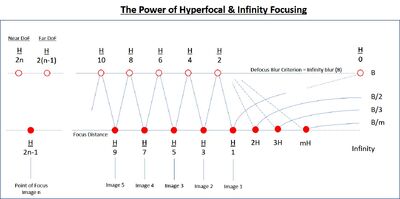
When focus bracketing we must at least ensure the previous image's far DoF is the same as the next image's near DoF: assuming we are focusing near to far as we are in this script. However, many wish to introduce some 'insurance' and have an overlap between the focus brackets. The script provides four options for this overlap: none, 2*CoC/3, CoC/2 and diffraction aware.
With diffraction aware overlap, the script calculates the defocus blur to use that ensures that the defocus blur and diffraction blur, taken together in quadrature, are equal to the CHDK CoC. This overlap blur criterion will never be less than the CHDK set CoC/3.
The following illustrates the overlap between image n and n+1. Note that using the overlap feature comes at the cost of needing to take more brackets
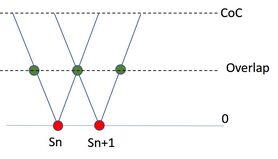
Having achieved the perfect focus brackets, the script will then create an additional bracket beyond H, ie to cover the infinity focus quality. The options being 2H, 3H or 4H, giving infinity blurs of CoC/2, CoC/3 or CoC/4. If diffraction aware is being used for the overlap, the last image will be around CoC/3.
Finally, the script provides an estimate of the number of brackets that will be taken, less the two bookend images. You can elect to terminate the script if this is too large by simply doing a full shutter press.
By default the script creates a dark image at the beginning and end of the focus bracket set, to help differentiate the sequence in post. You can turn this off via the menu.
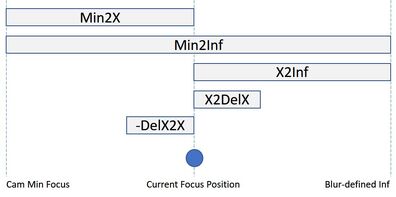
There are five focus bracketing strategies: current position to infinity (X2Inf), min camera focus to current position (Min2X), min camera focus to infinity (Min2INF), current position to delta X in front (X2DelX) and current position to delta X behind (-DelX2X).
Finally, although not shown, you can also select -D2+D, ie - del X to + del X.
Focus bracketing can be switched off, so that only exposure bracketing takes place
At each focus point you can also ask the script to create additional exposure brackets at either -xEv & +xEv, -xEv & --xEv or at +xEv and ++xEv. X can be 1 or 2Ev or 3Ev from the base exposure. These options cover all the usual exposure bracketing options, eg if following an ETTR approach, then a +/++ logic would be the best choice.
In addition to the 'normal' bracketing option, the script offers two additional schemes. First, an ISO-less bracketing option (at ISO 800 or ISO 1600) that assumes (sic) the camera is ISO-less above ISO 800 or 1600 (check your camera to ensure you select the right ISO so the sensor read noise swamps the banding). Thus there is no point in taking brackets in the camera above this, ie just push in post. The ISO option is good for hand-holding situations and the script assumes your base image is set to the base ISO.
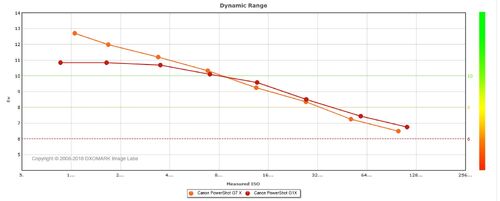
As an illustration, the chart on the right, from the DXOMark site, shows the G1X vs G7X. As can be seen the G7X can be assumed to be fully ISO invariant, which means doing ISO bracketing is pointless, ie simply push a single base exposure in post (as long as you are not too underexposed ;-))
On the other hand the G1X is only ISO-less above about 1600. Hence take a single additional bracket at, say, ISO1600.
The second additional scheme makes use of the 'Zero-Noise' approach, as suggested by Guillermo Lujik: http://www.guillermoluijk.com/article/nonoise/index_en.htm In this mode a second time bracket is taken at +4Ev or +3Ev or +2EV from the first one. To use the ZN option, simply ETTR to capture the highlights and the script will create an additional image for the shadow areas. But beware potential flares from bright highlights if you use the +4Ev option.
Finally, the script provides an automatic exposure bracketing option, that assumes your base exposure is set for the shadows.
To use the script, simply focus on the nearest point of interest, unless you are using the Min2 mode.
If focus bracketing has been requested, the script will pause to alert you to the number of focus brackets that will be taken (exposure brackets are on top of this) and, if you are bracketing to infinity, the infinity focus distance will be shown. To continue the script simply do a half shutter press or to terminate the script, ie too many brackets, do a full shutter press.
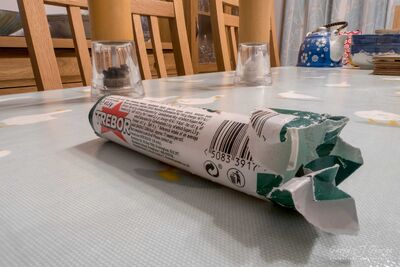
The script is started in the normal way, eg by doing a full shutter press.
The script doesn't require the camera to be any specific exposure mode. Thus it should run OK from M or Av mode. Note, if you are in AF mode to set your focus, obviously do this before switching to Alt mode and MF and running the script.
But watch out for the Canon Av restriction, ie Tv < 1s.
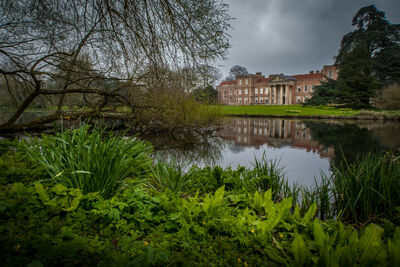
Here are a few test images I took with the script. The post processing was carried out in Lightroom, with a round trip to Helicon Focus.
Finally, you will find information about this script and other photography matters on my blog at photography.grayheron.net
Save to your /SCRIPTS/ folder as usual.
